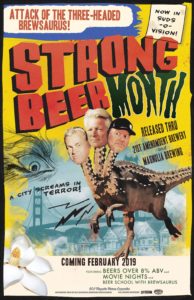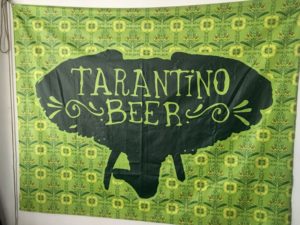Blending with Friends
There’s a quote attributed to Isaac Newton, invoked by our friends over at The Rare Barrel in Berkeley for their collaborative series of beers paying tribute to those who have gone before, which comes to mind as I begin to lay the groundwork for the wood-aged and sour beers program we at Magnolia will be pursuing once we get Magnolia Hall, the space adjacent to the Dogpatch restaurant and brewery, up and running. “If I have seen further, it is because I have stood on the shoulders of giants,” he wrote, presumably with such figures in mind as Ptolemy, Archimedes, Aristotle, Copernicus and Galileo. The Rare Barrel has done a nice job of homage with contributions from such Craft Beer luminaries as “Wicked” Pete Slosberg and Lauren Limbach of New Belgium, and as we prepare to install our beautiful old foeders and shiny new coolship it must be acknowledged that we won’t be going it alone.
First off, Lauren will be involved with our efforts as well, especially as she heads up the wood program of our Colorado parent company, and as it happens is the most recent winner of The Brewers Association’s Russell Schehrer Award for innovation and excellence in brewing. She has already provided extremely valuable advice as I’ve prepared to buy foeders and have our coolship manufactured, and as we contemplate the kinds of projects that will kick things off, wood-wise. She and I have talked about bringing in some of New Belgium’s wonderful wood beers, first for blending with things that we produce, and later for kick-starting our foeder inoculation program.
New Belgium works with two basic wood beers, the pale Felix and darker Oscar, with which they produce nearly all of their blends. Oscar is probably best recognized as the heart and soul of La Folie, while Felix has laid down the law in such beers as dry-hopped Le Terroir and the lovely peach of a beer, Eric’s Ale. Kim and I also used Felix a number of years ago when we collaborated on a sour pumpkin and cranberry beer called Kick. Once we get the foeders in place we’ll think about filling a couple of them with live beer from our friends at New Belgium, in order to complement some of the other things with which we’ll be feeling our way.
Meanwhile—and not to be putting too many eggs in a single basket—we’re also working with some other friends to the south, down at Firestone Walker’s Barrelworks in Buellton. I recently accepted an invitation from Jim Crooks, blendmaster for all the wonderful Barrelworks beers, to drive down and taste through several dozen barrels in anticipation of doing the same kind of thing (blending and inoculating) with beers of a bunch of different makeups. Barrelworks handles a number of different inocula, with varying amounts of microbiological this and that, and with which they produce such artfully blended favorites as Agrestic, Sour Opal, Bretta Weisse and Krieky Bones. Parenthetically, I like to think I had a mainly passive influence years ago on their decision to produce El Gourdo, a wild roasted pumpkin ale. In any case, Jim and his gang laid out a wood beer feast of individual barrel samples, intended to display the unadorned characteristics of beers they blend together to make the wonderful bottles with which many of us are familiar.
A couple of weeks later all the Magnolia brewers got together at my house for paella and the opportunity to taste through these beers in blended and finished form, thanks to the box that Jim sent up for us to sample. While not on the surface surprising, having tasted many single barrel examples so recently it was eye-opening and wonderful to have the immediate experience of seeing what Jim and his crew had made of the building blocks that is barrel-aged beer. It certainly got us all thinking.
The plan? Bring totes of wood-aged sour beer from both New Belgium and Barrelworks to fill a handful of our foeders, hoping that what takes up residence in the wood will eventually provide a palette of variation for us to play with into the future. In the meantime, we’ll produce beers of our own—and not all of them sour—with the idea of blending delicious hybrids we’ll perhaps bottle and also serve across the bar. The coolship? I knew you were wondering about that.
I have to be honest. Where the coolship is concerned we don’t at all know what to expect. As soon as we can—and damn the torpedoes where the weather is concerned—we’ll start experimenting with producing wort and cooling it in the coolship, allowing whatever microflora is resident in the Dogpatch air to inoculate the wort prior to running it into either a foeder or a straight-up stainless steel fermenter. And then we’ll see. We’ll see how it takes off and how it changes. We’ll see if it combines well with anything else we have on hand, either from other foeders or with more conventionally produced beers. We’ll see if it’s any good at all. Once again reverting to honesty, I’m sure we’ll put a fair amount of it down the drain. In any case, we are all looking forward to the experiments that—with help from our friends—will take us into our next creative phase. It’s hoped that whatever route we follow, delicious will be the destination.




